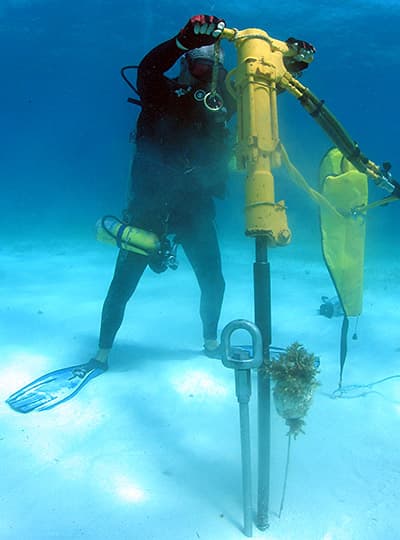John Halas

My name is John Halas, former Resource Manager for Florida Keys National Marine Sanctuary. I began working for the sanctuary in 1980 as biologist for Key Largo National Marine Sanctuary. I was the first employee following the 1975 designation -- ultimately retiring as manager of the upper region office of Florida Keys National Marine Sanctuary in 2012.
From my early 1970s upper Florida Keys experience as a biologist working for Harbor Branch Foundation/Smithsonian Institute based out of John Pennekamp State Park and my experience from mid to late 1970s as a Florida Keys dive charter boat operator and dive shop co-owner, I recognized the increasing coral damage that was occurring on the popular Key Largo reefs from boat anchors. Proactive measures needed to be taken.
Early in my sanctuary tenure, with the support of my supervisors, along with design advice from a local welder friend and the expertise and equipment use of my colleagues at U.S. Geological Survey, I was able to successfully test a unique "embedment" anchor system in a limestone base coral reef environment for safely securing multiple mooring buoy arrays to the bottom substrate without causing any nearby collateral damage.
This type buoy system was quickly embraced by the boating community, including the dive shop dive boat operators, and marked the dawn of the environmentally friendly reef mooring buoy system as we know it in the Florida Keys.
A few design changes and additions were made over time, including the development and use of a soft substrate embedment anchor for use around shallow reefs. Mooring buoys were established at Looe Key National Marine Sanctuary, and two nonprofit foundations established mooring buoys on popular reefs off Key West and Marathon before the establishment of Florida Keys National Marine Sanctuary.

The sanctuary then took responsibility for the management and maintenance of existing and newly-established buoys in the sanctuary with the exception of John Pennekamp State Park. The technology for installing the environmentally friendly embedment anchor mooring buoy system has been imported to many foreign countries for over 30 years and has become the "industry standard" in most tropical marine protected areas (MPAs) for managing and protecting resources from anchor damage.
One of the sanctuary's greatest accomplishments has been establishing a strong, cost-effective and environmentally friendly mooring buoy program. It is a tangible, visible action that works to protect the environment. I have heard it said in one of the Caribbean islands by an MPA staffer that it took establishing mooring buoys for the public to understand that they now really do have a "marine park".
Implementing an organized, funded, long-term mooring buoy program, even before finalizing the sanctuary, was of paramount importance for avoiding or reducing anchor damage. But the sanctuary helps protect the resources in the Florida Keys in several other ways.
Establishing Sanctuary Preservation Areas (SPAs) in critical sensitive areas with stronger protective regulations has been another effective measure. The soft-bottom embedment anchor along with the original design hard-bottom embedment anchor has enabled an accurate delineation of the SPA zone marking buoys to help make the SPAs workable and enforceable.
Another big plus was a strong sanctuary education program, particularly in the early years, as the public was getting used to the new program. On-water enforcement is necessary for the regulations that were established in the management plan, with steady, sufficient funding to adequately cover the sanctuary waters.
Scientific research to better understand the natural and human-induced factors that influence changes to the marine environment has been important and is needed to help continue an adaptive management program.
Historical resource management with public participation through a permit system was and has also been important, and influenced the original sanctuary designation. This is an evolving situation and will likely always be a challenge.
To me, Florida Keys National Marine Sanctuary is a hope to preserve and improve the Florida Keys marine environment that we have.
My hope for the future is that we can reduce the human-induced degradation to our marine environment and be able to successfully improve fish stocks and assist coral regeneration through large-scale coral transplanting projects.

